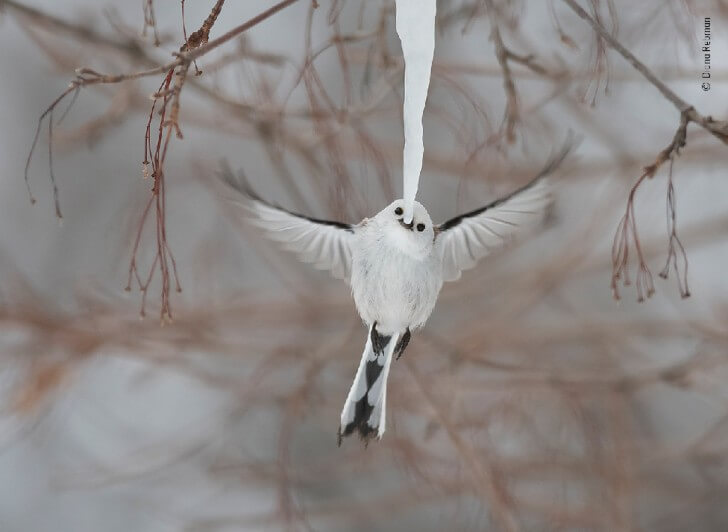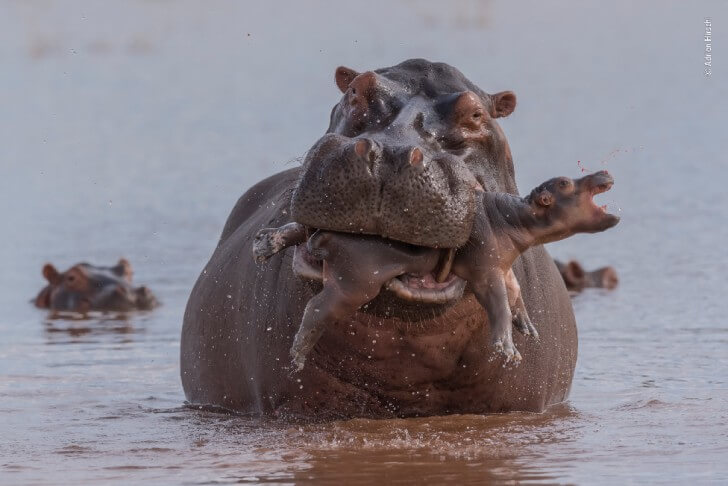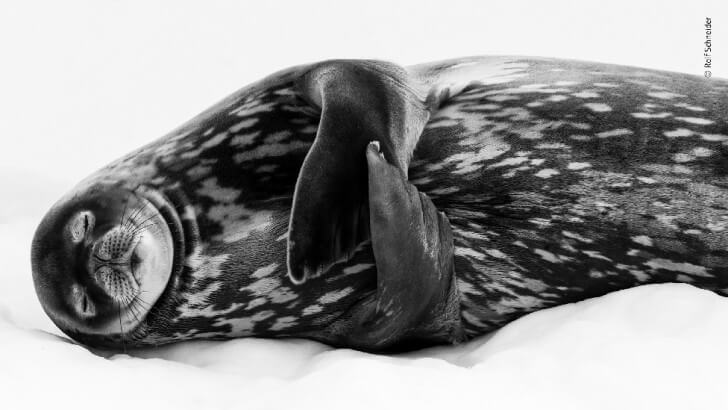BBC Earth newsletter
BBC Earth delivered direct to your inbox
Sign up to receive news, updates and exclusives from BBC Earth and related content from BBC Studios by email.
Animals
This year's Wildlife Photographer of the Year images reveal a world of wonder, change and heartbreak. Here are nine of our favourites.

A sleepy seal, a zombie beetle and a flying penguin are all among the highly commended images in this year's Wildlife Photographer of the Year. Here's your first look at some of the judges' favourites.
On a night-time field trip in the Peruvian Amazon rainforest, Frank Deschandol spotted this bizarre-looking weevil clinging to a fern stem.
Its glazed eyes showed it was dead and the three antennae-like projections growing out of its chest were the ripe fruiting bodies of a ‘zombie fungus’. Spreading inside the weevil while it was alive, the parasitic fungus had taken control of its muscles and compelled it to climb. When the fungus grew to a suitable height, the weevil held fast to the stem. Fuelled by the weevil’s insides, the fungus then started to grow fruiting bodies topped by capsules that would release a multitude of tiny spores to infect new prey. Shooting the weevil head on, Deschandol isolated the fungus against a soft background to emphasize the capsules. By the next day, the spores had been released and the fungus had withered, its deadly mission accomplished.

In a rare encounter, a lone male cheetah is set upon by a pack of painted wolves. Both species have disappeared from much of their former ranges, with fewer than 7,000 left of each, mainly due to habitat loss and fragmentation.
Peter Haygarth had been following the dogs by vehicle as they hunted in Zimanga Private Game Reserve, KwaZulu-Natal, South Africa. A warthog had just escaped the pack when the leading dogs came across the big cat. At first, the dogs were wary, but as the rest of the 12-strong pack arrived, their confidence grew, and they began to encircle the cat, chirping with excitement. The elderly cheetah hissed and lunged back at the mob, his left ear tattered, the right one pinned back in the ruckus. As dust flew in the morning light, Haygarth kept his focus on the cat’s face. In a few minutes the spat was over as the cheetah fled.

On a bitterly cold morning on the Japanese island of Hokkaido, Diana Rebman came across a delightful scene. A flock of long-tailed tits and marsh tits were gathered around a long icicle hanging from a branch, taking turns to nibble the tip. Here, a Hokkaido long-tailed tit hovers for a split second to take its turn to nip off a beakful. If the sun came out and a drop of water formed, the tit next ‘in line’ would sip rather than nip. The rotation of activity was so fast-moving that it almost seemed choreographed.
Two days later, Rebman returned and found that, with temperatures still at -20°C (-4°F), the icicle remained and tits were still drinking from it. But when the sun came out and the ice began to melt, one long‑tailed tit chose to cling to the icicle instead of hovering. That instantly brought the performance to an end, as the icicle cracked and then crashed to the ground

A newborn hippo, just days old, was keeping close to its mother in the shallows of Lake Kariba, Zimbabwe, when a large bull suddenly made a beeline for the pair. He chased the mother, then seized the calf in his huge jaws, clearly intent on killing it. After trying to drown it, he tried to crush it to death. All the while, the distraught mother looked on. Adrian Hirschi’s fast reaction and exposure captured the shocking drama.
Infanticide among hippos is rare, but may result from the stress caused through overcrowding when their day-resting pools dry out. A male may also increase his reproductive chances by killing young that are not his own, triggering females to go into oestrus, ready to mate with him. Male hippos are also aggressively territorial, and brutal fights are not uncommon. If they feel threatened by an accidental encounter, hippos will also attack and kill humans.

A curious young grey whale approaches a pair of hands reaching down from a tourist boat. In San Ignacio Lagoon, on the coast of Mexico’s Baja California, baby grey whales and their mothers actively seek contact with people for a head scratch or back rub. The lagoon is one of three that comprise a grey whale nursery and sanctuary – a key winter breeding ground for this surviving breeding population of grey whales in the eastern North Pacific.
Whaling left the western population near extinction and wiped out the population in the North Atlantic. But in the 1970s, a young whale approached a fisherman who dared to reach out and touch it. The trust between whales and humans built up, and today many females actively encourage their calves to interact with people. The fishermen have also gained a whale‑watching income in winter – now vital as fish populations and therefore catches are in decline. In San Ignacio Lagoon, a World Heritage Site, whale‑watching is carefully managed by the community. For Tom P Peschak, a veteran marine photographer and biologist, a whale that demanded petting and got too close for him to focus was a first. In this sanctuary, it is the wild animals that call the shots.

An ever-adaptable raccoon pokes her bandit-masked face out of a 1970s Ford Pinto on a deserted farm in Saskatchewan, Canada. In the back seat, her five playful kits trill with excitement. It was a sentiment shared by Jason Bantle, waiting silently in a nearby hide, who had been hoping for this chance every summer for several years.
The only access into the car was through the small hole in the cracked safety glass of the windscreen. The gap was blunt‑edged but too narrow a fit for a coyote (the primary predator of raccoons in the area), making this an ideal place for a mother raccoon to raise a family. On this evening, she paused at the exit to check the surroundings just long enough for Bantle to make his long twilight exposure. She then squeezed out to spend the night looking for food – anything from fruit, nuts and eggs to invertebrates and small vertebrates.

A gentoo penguin – the fastest underwater swimmer of all penguins – flees for its life as a leopard seal bursts out of the water. Eduardo Del Álamo was expecting it. He had spotted the penguin, resting on a fragment of broken ice. But he had also seen the leopard seal patrolling off the Antarctic Peninsula coast, close to the gentoo’s colony on Cuverville Island. As Del Álamo’s inflatable headed towards the penguin, the seal passed directly beneath the boat. Moments later, it surged out of the water, mouth open. The penguin made it off the ice, but the seal now seemed to turn the hunt into a game.
Leopard seals are formidable predators. Females can be 3.5m (11½ feet) long and weigh more than 500kg (1,100 pounds), males slightly less. Their slender bodies are builtfor speed, with wide jaws bearing long canines and sharply pointed molars. They hunt almost anything, from fish to the pups of other seal species. And they also play with their prey, as in this instance, with the leopard seal pursuing the penguin for more than 15 minutes before finally catching and eating it.

Hugging its flippers tight to its body, the Weddell seal closed its eyes and appeared to fall into a deep sleep. Lying on fast ice (ice attached to land) off Larsen Harbour, South Georgia, it was relatively safe from its predators – killer whales and leopard seals – and so could completely relax and digest.
Weddell seals are the world’s most southerly breeding mammals, populating inshore habitats around the Antarctic continent. Their large bodies are covered in a thick layer of blubber to keep them warm above and below the icy waters of the Southern Ocean. Feeding mainly on large fish, Weddell seals are impressive divers, capable of descending to more than 500m (1,640 feet). This helps them to hunt under water for long periods, sometimes more than an hour. Shooting from an inflatable boat, Ralf Schneider tightly framed the sleeping seal, using the white backdrop of ice and soft light from the overcast sky to mimic the effect of a studio portrait. Converting his image to black and white accentuated the tones and textures of the seal’s dense mottled fur.

When Carlos Pérez Naval’s family planned a trip to Panama’s Soberanía National Park, sloths were high on their must-see agenda. They were not disappointed. For several days, from the observation deck of the park’s canopy tower, Naval could photograph not only birds but also this brown-throated three-toed sloth – the orange fur and the dark stripe on its back marking it as an adult male. It hung out in a cecropia tree, resting but occasionally moving, slowly, along a branch to reach new leaves.
On this morning, with the forest cloaked in fog and the sloth on the move, Naval decided on a new composition. Climbing down, he shot from a lower level but at an angle that would still show the sloth’s key features – its three hooked claws clamped to the branch, its characteristic mask-like eye-stripe and its long, coarse fur. But by deliberately placing it in one part of the frame, he also captured the atmosphere of the forest – ‘the sloth in its environment’.
The Wildlife Photographer of the Year winners and runners up will be showcased at the Natural History Museum in London from 18th October 2019.
Featured image © Eduardo Del Álamo